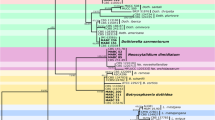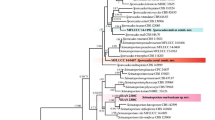Abstract
Isolates with conidial morphologies corresponding to botryosphaeriaceous species were obtained from adult grapevines (Vitis vinifera) showing symptoms of die-back and esca in vineyards from all grape-growing regions of Uruguay and also from canes of asymptomatic mother plants in a commercial nursery. The morphological description of some of the anamorphs matched with their ITS phylogeny, which allowed for the identification of Botryosphaeria dothidea, Diplodia seriata, and Neofusicoccum luteum. Combined analysis of the ITS region and partial translation elongation factor further confirmed the presence of Lasiodiplodia theobromae and Neofusicoccum australe. Isolates belonging with the Neofusicoccum parvum/ribis complex were identified as N. parvum and N. kwambonambiense based on sequence analysis of the RNA polymerase II subunit (RPB2). Lasiodiplodia theobromae, N. parvum, N. kwambonambiense and N. australe are described for the first time from grapevines in Uruguay, while N. kwambonambiense is reported in a different territory and host from those in which this cryptic species was originally described.



Similar content being viewed by others
References
Abreo E (2011) Comunidad fúngica asociada a las enfermedades del tronco de la vid en Uruguay: composición, diagnóstico molecular, patogenicidad. Tesis Doctorado en Biología, PEDECIBA, UdelaR, Uruguay
Abreo E, Lupo S, Bettucci L (2012) Fungal community of grapevine trunk diseases: a continuum of symptoms? Sydowia 64:1–12
Alonso R, Tiscornia S, Couto Alfenas A, Bettucci L (2009) Fungi associated to bark lesions of Eucalyptus globulus stems in plantations from Uruguay. Árvore 33:591–597
Amponsah NT, Jones EE, Ridgway HJ, Jaspers MV (2011) Identification, potential inoculum sources and pathogenicity of botryosphaeriaceous species associated with grapevine dieback disease in New Zealand. Eur J Plant Pathol 131:467–482. doi:10.1007/s10658-011-9823-1
Auger J, Esterio M, Ricke G, Perez I (2004) Black dead arm and basal canker of Vitis vinifera cv. Red Globe caused by Botryosphaeria obtusa in Chile. Plant Dis 88:1286
Baskarathevan J, Jaspers MV, Jones EE, Ridgway HJ (2012) Incidence and distribution of botryosphaeriaceous species in New Zealand vineyards. Eur J Plant Pathol 132:549–560. doi:10.1007/s10658-011-9900-5
Bettucci L, Alonso R (1997) A comparative study of fungal populations in healthy and syptomatic twigs of Eucalyptus grandis in Uruguay. Mycol Res 101:1060–1064
Bettucci L, Alonso R, Simeto S, Lupo S (2004) Endophytic fungi of twigs and leaves from three wild species of Myrtaceae. Sydowia 56:8–23
Carbone I, Kohn LM (1999) A method for designing primer sets for speciation studies in filamentous ascomycetes. Mycologia 91:553–556
Chifflet S (1975) Marchitamiento de los pinos producido por Diplodia pinea (Desm.) Kickx. Revista Asociación Ingenieros Agrónomos N°4, 22–25
Delgado-Cerrone LM, Mondino P, Alaniz S (2012) Characterization of Botryosphaeriaceae species associated with apple crop in Uruguay. XXXV Congresso Paulista de Fitopatologia. Asociacao Paulista de Fitopatología, Jaguariúma-SP, Brasil, v38
Ferrer M, Pedocchi R, Michelazzo M, González Neves G, Carbonneau A (2007) Delimitación y descripción de regiones vitícolas del Uruguay en base al método de clasificación climática multicriterio utilizando índices bioclimáticos adaptados a las condiciones del cultivo. Agrociencia (Uruguay) 11:47–56
Hillis DM, Bull JJ (1993) An empirical test of bootstrapping as a method for assessing confidence in phylogenetic analysis. Syst Biol 42:142–152
Lazzizera C, Frisullo S, Alves A, Phillips AJL (2008) Morphology, phylogeny and pathogenicity of Botryosphaeria and Neofusicoccum species associated with drupe rot of olives in southern Italy. Plant Pathol 57:948–956
Lee S, Taylor J (1990) Isolation of DNA from fungal mycelia and single spores. In: Innis MA, Gelfand DH, Snindky JJ, White TJ (eds) PCR protocols: a guide to methods and applications. Academic, New York, pp 282–287
Martínez S, Abreo E, Bettucci L, Lupo S (2009) Especies de Botryosphaeria asociadas a Vitis vinifera en Uruguay. Libro de resúmenes. XV Congreso Latinoamericano y XVIII Congreso Chileno de Fitopatología. Asociación Latinoamericana de Fitopatología-Sociedad Chilena de Fitopatología, Santiago, Chile, p 260
Pavlic D, Slippers B, Coutinho TA, Wingfield MJ (2009a) Molecular and phenotypic characterization of three phylogenetic species discovered within the Neofusicoccum parvum/N. ribis complex. Mycologia 101:636–647. doi:10.3852/08-193
Pavlic D, Slippers B, Coutinho TA, Wingfield MJ (2009b) Multiple gene genealogies and phenotypic data reveal cryptic species of the Botryosphaeriaceae: A case study on the Neofusicoccum parvum/N. ribis complex. Mol Phylogenet Evol 51:259–268
Perez CA, Wingfield MJ, Slippers B, Altier NA, Blanchette RA (2010) Endophytic and canker-associated Botryiosphaeriaceae occurring on non-native Eucalyptus and native Myrtaceae trees in Uruguay. Fungal Divers 41:53–69
Phillips AJL (2002) Botryosphaeria species associated with diseases of grapevines in Portugal. Phytopathol Mediterr 41:3–18
Pitt WM, Huang R, Steel CC, Savocchia S (2010) Identification, distribution and current taxonomy of Botryosphaeriaceae species associated with grapevine decline in New South Wales and South Australia. Aust J Grape Wine Res 16:258–271
Punithalingam E (1980) Plant diseases attributed to Botryodiplodia theobromae Pat. J. Cramer, Vadus, Germany, p 121
Qiu Y, Steel CC, Ash GJ, Savocchia S (2010) Survey of Botryosphaeriaceae associated with grapevine decline in the Hunter Valley and Mudgee grape growing regions of New South Wales. Australas Plant Pathol 40:1–11
Sakalidis M (2004) Resolving the Botryosphaeria ribis—Botryosphaeria parva species complex; a molecular and phenotypic investigation. Honors Thesis. School of Biological Sciences and Biotechnology, Murdoch University, Western Australia
Sakalidis ML, Hardy GESTJ, Burgess TI (2011a) Use of the Genealogical Sorting Index (GSI) to delineate species boundaries in the Neofusicoccum parvum–Neofusicoccum ribis species complex. Mol Phylogenet Evol 60:333–344
Sakalidis ML, Hardy GESTJ, Burgess TI (2011b) Class III endophytes, clandestine movement amongst hosts and habitats and their potential for disease; a focus on Neofusicoccum australe. Australas Plant Pathol 40:510–521. doi:10.1007/s13313-011-0077-3
Savocchia S, Steel CC, Stodart BJ, Somers A (2007) Pathogenicity of Botryosphaeria species isolated from declining grapevines in sub tropical regions of Eastern Australia. Vitis 46:27–32
Slippers B, Wingfield MJ (2007) The Botryosphaeriaceae as endophytes and latent pathogens of trees: Identification, ecology and potential impact. Fungal Biol Rev 21:90–106
Swofford DL (2003) PAUP* Phylogenetic Analysis Using Parsimony (*and other methods). Version 4. Sinauer Associates, Sunderland, MA
Tamura K, Peterson D, Peterson N, Stecher G, Nei M, Kumar S (2011) Mega:5 Molecular evolutionary genetics analysis using maximum likelihood, evolutionary distance, and maximum parsimony methods. Mol Biol Evol 28:2731–2739
Taylor A, Hardy GESTJ, Wood P, Burgess T (2005) Identification and pathogenicity of Botryosphaeria species associated with grapevine decline in Western Australia. Australas Plant Pathol 34:187–195
Thompson JD, Higgins DG, Gibson TJ (1994) CLUSTAL W: improving the sensitivity of progressive multiple sequence alignment through sequence weighting, position-specific gap penalties and weight matrix choice. Nucleic Acids Res 22:4673–4680
Úrbez-Torres JR (2011) The status of Botryosphaeriaceae species infecting grapevines. Phytopathol Mediterr 50:S5–S45
Úrbez-Torres JR, Gubler WD (2009) Pathogenicity of Botryosphaeriaceae species isolated from grapevine cankers in California. Plant Dis 93:584–592
Úrbez-Torres JR, Leavitt GM, Voegel TM, Gubler WD (2006) Identification and distribution of Botryosphaeria spp. associated with grapevine cankers in California. Plant Dis 90:584–592
van Niekerk JM, Crous PW, Groenewald JZ, Fourie G, Halleen F (2004) DNA phylogeny, morphology and pathogenicity of Botryosphaeria species on grapevines. Mycologia 96:781–798
White TJ, Bruns T, Lee S, Taylor J (1990) Amplification and direct sequencing of fungal ribosomal RNA genes for phylogenetics. In: Innis MA, Gelfand DH, Snindky JJ, White TJ (eds) PCR protocols: a guide to methods and applications. Academic, New York, pp 315–322
Acknowledgments
We thank INIA-FPTA, PEDECIBA-Universidad de la República and the Agencia Nacional de Investigación e Innovación for financial support.
Author information
Authors and Affiliations
Corresponding author
Rights and permissions
About this article
Cite this article
Abreo, E., Martinez, S., Bettucci, L. et al. Characterization of Botryosphaeriaceae species associated with grapevines in Uruguay. Australasian Plant Pathol. 42, 241–249 (2013). https://doi.org/10.1007/s13313-013-0200-8
Received:
Accepted:
Published:
Issue Date:
DOI: https://doi.org/10.1007/s13313-013-0200-8




